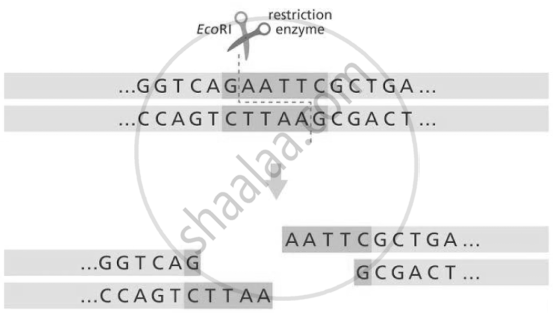Advertisements
Advertisements
प्रश्न
'EcoRI' has played a very significant role in rDNA technology.
- Explain the convention for naming EcoRI.
- Write the recognition site and the cleavage sites of this restriction endonuclease.
उत्तर
(I) Restriction endonucleases are named as follows:
1st alphabet represents the genus of the organism from which the enzyme is isolated.
2nd and 3rd alphabet represent the species of the organism.
4th alphabet represents the strain.
The Roman number represents the order of isolation or discovery of the enzyme.
EcoRI comes from the Escherichia coli RYB strain.
In EcoRI, 'E' comes from the genus 'Escherichia' and 'co' comes from the species name 'Coli'.
The letter 'R' is derived from the name of the strain RYB.
Roman numbers following the names indicate the order in which the enzymes were isolated from that strain of bacteria.
(II) The recognition sequence where EcoRI cleaves the DNA molecule is G/AATTC. Such sequences have a complementary sequence, CTTAA/G, which is known as a palindromic sequence.

APPEARS IN
संबंधित प्रश्न
Collect 5 examples of palindromic DNA sequences. Better try to create a palindromic sequence by following base-pair rules.
Explain briefly:
Restriction enzymes and DNA
Distinguish between exonuclease and endonuclease
Give a reason why :
Single cloning site is preferred in a vector.
DNA fragments separate according to size through?
Which of the following enzymes catalyse the removal of nucleotides from the ends of DNA?
'Restriction' in Restriction enzyme refers to ______.
Would you choose an exonuclease while producing a recombinant DNA molecule?
A plasmid DNA and a linear DNA (both are of the same size) have one site for a restriction endonuclease. When cut and separated on agarose gel electrophoresis, plasmid shows one DNA band while linear DNA shows two fragments. Explain.
Given below is the stepwise schematic representation of the process of electrophoresis. Identify the 'alphabets' representing
- Anode end
- smallest/lightest DNA strand in the matrix
- Agarose gel

